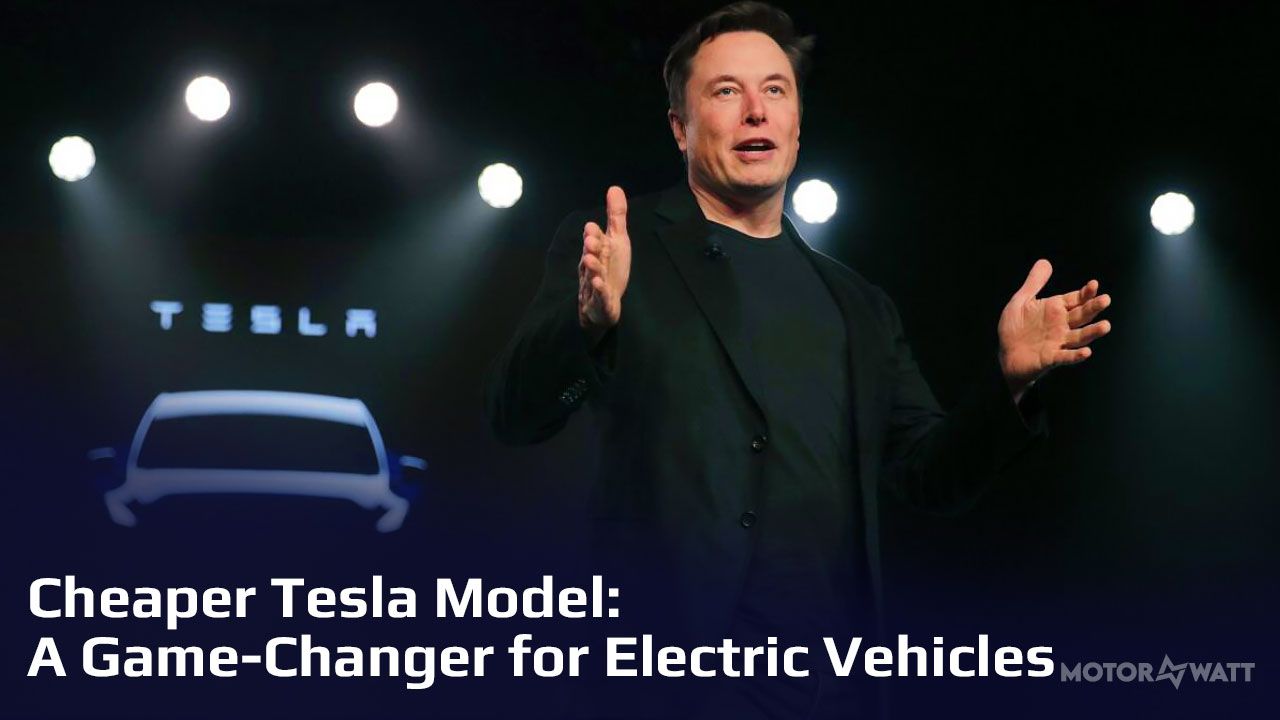Cheaper Tesla Model: A Game-Changer for Electric Vehicles
Share this article in Social Media:

The cheaper Tesla Model, set for production in 2025, promises a $25,000 price tag, around 200-250 miles of range, compact size, Tesla tech, and optional autonomous capabilities to revolutionize affordable EVs.
The electric vehicle (EV) market is buzzing with excitement as Tesla prepares to launch its much-anticipated cheaper Tesla Model, a vehicle designed to make EV ownership more accessible to the masses. With production slated to begin in the first half of 2025, this new offering promises to shake up the automotive industry by combining Tesla’s cutting-edge technology with a price point that appeals to budget-conscious consumers. As competition intensifies and Tesla navigates declining sales, the cheaper Tesla Model is poised to redefine affordability in the EV space. In this blog post, we’ll explore the anticipation surrounding this vehicle, its expected features, and why it matters in today’s competitive market.
Why the Cheaper Tesla Model Matters
The demand for affordable electric vehicles has never been higher. With rising fuel costs and growing environmental concerns, consumers are eager to transition to EVs, but high price tags often stand in the way. Tesla, known for its premium offerings like the Model S and Model X, has historically catered to a higher-income demographic. However, the introduction of a cheaper Tesla Model signals a strategic pivot to capture a broader market. This move is particularly crucial as Tesla faces mounting competition from rivals like BYD, Rivian, and even Slate Auto, which recently launched a $20,000 electric truck.
Elon Musk, Tesla’s CEO, has long teased the idea of a budget-friendly EV, often referred to as the “$25,000 Tesla.” While exact pricing remains unconfirmed, reports suggest the cheaper Tesla Model will be priced significantly lower than the current Model 3, which starts at around $40,000. By targeting a lower price point, Tesla aims to address declining sales—evidenced by a 13% drop in deliveries in Q1 2025—and reassert its dominance in the EV market. For consumers, this model represents an opportunity to own a Tesla without breaking the bank, making sustainable transportation more attainable.
Expected Features of the Cheaper Tesla Model
While Tesla has kept many details under wraps, industry reports and leaks provide insight into what the cheaper Tesla Model might offer. To achieve a lower price, Tesla is expected to incorporate cost-cutting measures while retaining the core elements that make its vehicles iconic. The new model is likely to resemble the design of the Model 3 or Model Y, ensuring brand continuity and leveraging existing production lines to minimize costs.
Key features include:
- Smaller Battery Pack: The cheaper Tesla Model is rumored to feature a 50 kWh battery, smaller than the 60-75 kWh packs found in current models. While this may result in a reduced range—potentially around 200-250 miles—it aligns with the needs of urban commuters and budget-conscious buyers.
- Simplified Design: To cut costs, Tesla may eliminate premium features like the glass roof, ambient lighting, and dual-pane windows, opting for single-pane windows and a more utilitarian interior.
- Streamlined Technology: The vehicle will likely retain Tesla’s signature touchscreen interface and basic Autopilot capabilities but may forgo advanced options like Full Self-Driving (FSD) as a standard feature.
- Compact Size: The cheaper Tesla Model is expected to be slightly smaller than the Model 3, making it easier to maneuver in crowded cities and more affordable to produce.
These compromises allow Tesla to lower the price while delivering a vehicle that still feels like a Tesla—sleek, tech-forward, and environmentally friendly. For consumers searching for a cheaper Tesla Model, these features strike a balance between affordability and innovation.
Competitive Pressures Driving Tesla’s Strategy
The EV market is more competitive than ever, and Tesla is feeling the heat. Chinese automaker BYD has gained ground with its affordable EVs and advanced self-driving technology, while startups like Slate Auto are undercutting Tesla with budget-friendly offerings. In April 2025, Slate Auto unveiled a $20,000 electric truck, directly challenging Tesla’s long-promised affordable EV. Meanwhile, established players like Ford and General Motors are rolling out competitively priced electric models, further crowding the market.
Tesla’s decision to fast-track the cheaper Tesla Model is a direct response to these pressures. The company’s Q1 2025 financials revealed a 71% profit drop, driven by declining demand and increased competition. By introducing a more affordable vehicle, Tesla aims to recapture market share and appeal to cost-conscious consumers who might otherwise opt for rival brands. Additionally, Tesla’s focus on cost reduction aligns with its broader strategy to scale production and achieve economies of scale, ensuring long-term profitability.
The Role of Autonomous Driving in the Cheaper Tesla Model
Tesla’s vision for the future extends beyond affordability—it’s deeply tied to autonomous driving. The cheaper Tesla Model is expected to play a role in Tesla’s robotaxi ambitions, with Elon Musk projecting commercial robotaxi operations by late 2026. While the base model may not include advanced self-driving features, it will likely be equipped with the hardware necessary for future upgrades, allowing owners to opt into Tesla’s Full Self-Driving (FSD) system.
This focus on autonomy is a double-edged sword. On one hand, it positions the cheaper Tesla Model as a forward-thinking investment, capable of evolving with Tesla’s software updates. On the other, the high cost of FSD—currently priced at $8,000-$12,000—may deter budget-conscious buyers. Tesla’s challenge will be to balance affordability with the promise of cutting-edge technology, ensuring the cheaper Tesla Model remains accessible while supporting the company’s autonomous driving goals.
Consumer and Investor Reactions
The buzz surrounding the cheaper Tesla Model has sparked a mix of excitement and skepticism. On platforms like X, consumers are vocal about their desire for an affordable Tesla, with many praising the potential for a sub-$30,000 EV. However, some express concerns about the compromises, such as reduced range and fewer premium features. Others question whether Tesla can deliver on its promises, given delays with previous projects like the Cybertruck and the original $25,000 EV.
Investors, meanwhile, are cautiously optimistic. Tesla’s stock surged in late April 2025 after Musk announced a renewed focus on the company, but the 71% profit drop has raised red flags. The success of the cheaper Tesla Model will be critical to restoring investor confidence and proving that Tesla can compete in the mass-market EV segment. As production ramps up in 2025, all eyes will be on Tesla’s ability to deliver a high-quality, affordable vehicle on time.
What’s Next for the Cheaper Tesla Model?
As the first half of 2025 approaches, anticipation for the cheaper Tesla Model continues to build. Tesla has yet to confirm an official unveiling date, but industry insiders expect a reveal in early 2025, with pre-orders opening shortly after. The vehicle’s success will hinge on Tesla’s ability to balance cost, quality, and brand appeal while navigating a fiercely competitive market.
For consumers, the cheaper Tesla Model represents a chance to join the EV revolution without the premium price tag. For Tesla, it’s a make-or-break moment to reclaim its position as the leader in electric vehicles. Whether you’re a Tesla enthusiast or a budget-conscious buyer, this new model is one to watch. Stay tuned for updates as Tesla prepares to redefine affordability in the EV world.










